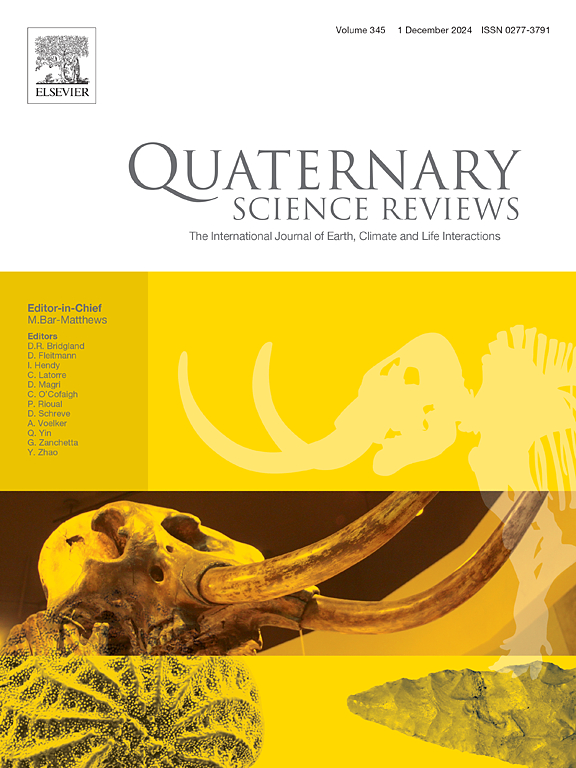Radiocarbon constraints on North Indian deep ocean ventilation and deglacial carbon dioxide release
IF 3.2
1区 地球科学
Q1 GEOGRAPHY, PHYSICAL
引用次数: 0
Abstract
Late Quaternary Indian Ocean circulation evolution and its role in carbon cycle dynamics remain poorly constrained. Here, we reconstructed the radiocarbon ventilation history of the North Indian Ocean over the past 30 kyr BP, using core I106 at the Ninetyeast Ridge. The results show higher 14C ventilation ages (Benthic-Atmospheric 14C offsets reaching ∼3000 yrs in average) during the last glacial period than nowadays, indicating that deep-water ventilation of the glacial North Indian Ocean was reduced and Indian Deep Waters (IDWs) were part of the glacial aged carbon pool. They also present a rapid rise in ventilation of IDWs during late Heinrich Stadial 1 and the Younger Dryas event, consistent with existing stable isotope data and Nd isotope trends that imply an enhanced inflow of well-ventilated, low-CO2 North Atlantic Deep Water (NADW) into the North Indian Ocean. The increase in ventilation of IDWs and NADW incursion would have caused a shift of the deep-ocean carbon pool with evidence of degassing from the North Indian Ocean. Together with 14C ventilation records in the Indian sector of the Southern Ocean, it can be inferred that portions of deep Indian Ocean carbon pool were likely transferred via the IDW transport southward and subsequently released to the atmosphere from the Southern Ocean. These findings highlight that part of 14C-depleted, CO2-rich IDWs contributed to the rapid rise in deglacial atmospheric CO2 via a Southern Ocean link.
北印度深海通风和去冰期二氧化碳释放的放射性碳限制
晚第四纪印度洋环流演化及其在碳循环动力学中的作用仍然知之甚少。在此,我们利用nietyeast Ridge的I106岩心重建了北印度洋过去30kyr BP的放射性碳通气历史。结果表明,末次冰期的14C通风年龄(海底-大气14C抵消平均达到~ 3000年)高于现在,表明冰期北印度洋的深水通风减少,印度深水(IDWs)是冰川时代碳库的一部分。它们还表明,在Heinrich Stadial 1晚期和新仙女木事件期间,idw的通气迅速增加,这与现有的稳定同位素数据和Nd同位素趋势一致,表明通风良好、低二氧化碳的北大西洋深水(NADW)流入北印度洋的增强。idw通气的增加和NADW的入侵将导致深海碳库的转移,并有证据表明北印度洋的脱气。结合南大洋印度洋板块的14C通风记录,可以推断,部分印度洋深层碳库可能通过IDW向南运输转移,随后从南大洋释放到大气中。这些发现突出表明,部分缺乏14c、富含二氧化碳的idw通过南大洋的联系导致了冰川消融大气中二氧化碳的快速上升。
本文章由计算机程序翻译,如有差异,请以英文原文为准。
求助全文
约1分钟内获得全文
求助全文
来源期刊

Quaternary Science Reviews
地学-地球科学综合
CiteScore
7.50
自引率
15.00%
发文量
388
审稿时长
3 months
期刊介绍:
Quaternary Science Reviews caters for all aspects of Quaternary science, and includes, for example, geology, geomorphology, geography, archaeology, soil science, palaeobotany, palaeontology, palaeoclimatology and the full range of applicable dating methods. The dividing line between what constitutes the review paper and one which contains new original data is not easy to establish, so QSR also publishes papers with new data especially if these perform a review function. All the Quaternary sciences are changing rapidly and subject to re-evaluation as the pace of discovery quickens; thus the diverse but comprehensive role of Quaternary Science Reviews keeps readers abreast of the wider issues relating to new developments in the field.
 求助内容:
求助内容: 应助结果提醒方式:
应助结果提醒方式:


